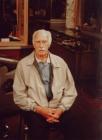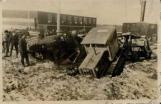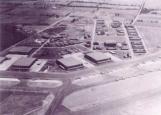1
Prince Edward Island - Wartime Memories of World War IIThe following exhibit tells the stories of seven ordinary Islanders and describes their personal experiences before, during and after the war.
3
On September 10, 1939 Canada declares war on Germany. The second war lasted six years, and left a legacy of death and destruction around the world. Canadian's fought against the Nazi's in Europe, Africa and in Hong Kong against the Japanese. We fought on the land, in the air and at sea.December 17, 1939 the 1st Canadian Division landed in Scotland. From this time onward til the war was over in May 1945, 47,000 Canadians gave their lives, another 55,000 were wounded and 11,000 were taken prisoner.
4
Sid Clay, Charlottetown.10 June 2003
Prince Edward Island Regiment Museum - Charlottetown, Prince Edward Island

5
Text from audio file:"Well, I'm Sid Clay. I've been living in Charlottetown for about 57 years now,and plus that I was over here for two years in Charlottetown in the RAF station during the war - 1941-42."
7
Text from audio file:"It was just after my twentieth birthday, when I arrived in Charlottetown and I had already been in the airforce for four years. I joined in January 1937 at the age of sixteen, and one month to train as an air engine and airframe fitter. Rig an aircraft, take it apart put it back together same for the engine. It was a three year apprenticeship, it was cut short a little when war broke out. We signed up at age sixteen on a twelve year term, and that twelve year term didn't start til you were age eighteen, so you were thirty when you came out, or you could renew for twelve years. But of course when the war broke out all those contracts went out the window, and we were in it for the duration of the war, no matter how long it lasted."
8
British Commonwealth Air Training Plan.One of the most important Canadian contributions to the war was the British Commonwealth Air Training Plan (BCATP).
This Agreement was signed in 1939. Canada and England constructed bases to train airmen from every part of the Commonwealth. These training centre's were constructed across Canada and helped to train 131, 533 pilots, observers, flight engineers and other air crew.
9
Jack Meredith, wireless air gunner for the Royal Air Force.10 June 2003
Prince Edward Island Regiment Museum - Charlottetown, Prince Edward Island

10
Text from Audio:"I enlisted when I was 18, 1939. After basic training I went to No. 1 Wireless School in Yatebury in Wiltshire, and did my wireless training there. A very interesting part, part of the wireless training that we had to learn air to ground operating. We had an old DeHavelin Rapid which was equipped with four different radio sets. When I went for my first trip, we sat at the set waiting for the pilot to come. The aircraft was sitting there with the engine idling. The pilot came in after a few minutes and he was a Corporal. He climbed in behind the pilot's seat and away we went. The next day the same thing, another trip, the pilot when he came in this time was an LAC which is one rank lower than a Corporal. That changed tremendously after the war started. Most anybody you saw flying was at least a Sergeant. "
"After my wireless training, the war started in September and in October I was posted to the British Expedition Forces in France where I had to do what we called Army Co-operation Work. We used to go spotting for enemy targets, concentrations of troops or railway heads, or buildings that were potentially harboring Gestapo headquarters and direct the artillery by radio signals. We would stay aloft til the artillery sent out one barrage, when we saw where they (the shells) landed, if it needed any alteration we would give them new co-ordinates. Then we would move out of there pretty fast, after the first salvo, there would be retaliation coming before then."
11
Under the British Commonwealth Air Training Plan three bases were established on Prince Edward Island.The initial station was established in Charlottetown by the RAF (Royal Air Force), with two RCAF (Royal Canadian Air Force) stations being established in Summerside and Mount Pleasant, Prince Edward Island.
12
Airmen arriving near the new Prince Edward Island base contended with "14 inches of soft, red mud."1941

13
Text From Audio:"It was a Sunday evening and it had been raining and on the way from Borden to Charlottetown on the train, we were informed that we would have a four mile walk ahead of us. You have to understand that the Airport was still being built, it wasn't finished in those days, and there was no transportation, there was practically nothing there."
"So coming off the station platform onto the bottom of King Street we had to form a line and get ready for the four mile walk. When the people stood around realized what was going on they started volunteering their automobiles, trucks and whatever to take us out there. I myself went up in the back of a truck."
"But an amusing incident. I can remember walking off the platform and an Air Force fella ahead of me, he was a Welshman, and there was one man shaking his hand saying 'Welcome to Charlottetown'. And the Welshman says 'Hi Mate, thanks a lot' he says 'What time do the pubs close?' Now that was a shocker because we had no idea that Prince Edward Island was one hundred percent prohibition. There was no place you could get a drink of beer unless you went to the bootleggers. Of which there were plenty at that time."
"And we eventually got to the camp in his truck and we were called out by names for the buildings we went to. I was in the Air Flight so I went to the A building. When we got word to move off, the roadways had been paved but there had been nothing done between the roadways and the buildings. We stepped of the roadway into about fourteen inches of soft red mud."
"A hard welcome to Prince Edward Island."
14
Arial View of RAF (Royal Air Force) Station, Charlottetown.1941
Charlottetown Airport - Charlottetown, Prince Edward Island


